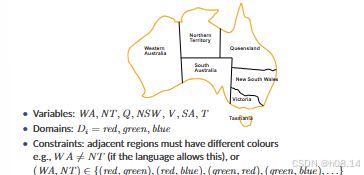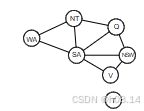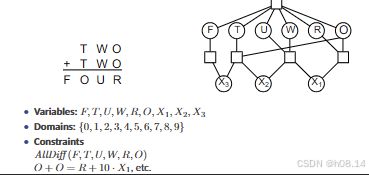AI基础 L13 Constraint Satisfaction Problems I约束满足问题
Defining Constraint Satisfaction Problems
A constraint satisfaction problem (CSP) consists of three components, X, D, and C:
• X is a set of variables, {X1, . . . , Xn}.
• D is a set of domains, {D1, . . . , Dn}, one for each variable
• C is a set of constraints that specify allowable combination of values CSPs deal with assignments of values to variables.
• A complete assignment is one in which every variable is assigned a value
— A solution to a CSP is a consistent, complete assignment.
• A partial assignment is one that leaves some variables unassigned.
• Partial solution is a partial assignment that is consistent
约束满足问题(CSP)
约束满足问题是一个由三个主要组成部分组成的问题类型:
-
变量集(X):
- 变量集
X包含一组变量,通常表示为{X1, . . . , Xn}。每个变量代表问题中的一个决策点或决策元素。
- 变量集
-
域集(D):
- 域集
D包含一组域,每个域对应一个变量,表示为{D1, . . . , Dn}。域Di包含所有可能的值,每个值可以被分配给变量Xi。
- 域集
-
约束集(C):
- 约束集
C包含一组约束,这些约束定义了变量值之间的允许组合。这些约束限制了变量可以取的值,以保证问题的解是有效的。
- 约束集
CSPs 涉及的任务
CSPs 涉及的任务是分配值给变量,以满足所有约束。
解(Solution)
-
完整分配(Complete assignment):
- 完整分配是指每个变量都被分配了一个值。
- 解决方案(Solution):
- CSPs 的解决方案是一个一致的、完整的分配,即满足所有约束的分配。
-
部分分配(Partial assignment):
- 部分分配是指一些变量没有分配值。
- 部分解决方案(Partial solution):
- 部分解决方案是一个一致的、部分分配,即满足当前分配下所有约束的分配。
• Standard search problem:
— state is a “black box” — any old data structure that supports goal test, eval, successor
• CSP:
— state is defined by variables Xi with values from domain Di
— goal test is a set of constraints specifying allowable combinations of values for subsets of variables
• Simple example of a formal representation language
• Allows useful general-purpose algorithms with more power than standard search algorithms
-
状态(State):
- 状态可以是任何数据结构,只要它能够存储和更新问题状态的信息。
-
目标测试(Goal test):
- 目标测试是一个函数,用于判断当前状态是否达到了问题的目标状态。
-
评估(Evaluation):
- 评估函数用于评估当前状态的优劣,这通常用于启发式搜索算法中。
-
成功继任者(Successor):
- 成功继任者函数用于从当前状态生成新的状态,这些新状态是当前状态的合法继任者。
Map-Colouring
Constraint graph
• Binary CSP: each constraint relates at most two variables
• Constraint graph: nodes are variables, arcs show constraints
General-purpose CSP algorithms use the graph structure
Varieties of CSPs
• Discrete variables
— finite domains; size d ⇒ O(dn) complete assignments
e.g., Boolean CSPs, incl. Boolean satisfiability (NP-complete)
infinite domains (integers, strings, etc.)
e.g., job scheduling, variables are start/end days for each job
— need a constraint language, e.g., StartJob1 + 5 ≤ StartJob3
— linear constraints solvable, nonlinear undecidable
• Continuous variables
e.g., start/end times for Hubble Telescope observations
— linear constraints solvable in poly time by LP methods
• Unary constraints involve a single variable,
e.g., S A̸ = green
• Binary constraints involve pairs of variables,
e.g., S A̸ = W A
• Higher-order constraints involve 3 or more variables,
e.g., cryptarithmetic column constraints
• Preferences (soft constraints),
e.g., red is better than green
• often representable by a cost for each variable assignment
→ constrained optimization problems
离散变量的CSPs
离散变量的CSPs涉及具有有限域的变量,例如布尔变量、整数、字符串等。
- 特点:
- 变量具有有限域,如布尔值、整数或字符串。
- 解决方案的数量随着变量数量的增加而指数级增长。
无限域的CSPs
无限域的CSPs涉及具有无限域的变量,例如整数、字符串等。
- 特点:
- 变量具有无限域,如整数或字符串。
- 需要一种约束语言来表达变量之间的约束关系。
- 线性约束是可解决的,但非线性约束是不可判定的。
连续变量的CSPs
连续变量的CSPs涉及具有连续域的变量,例如天文观测的开始和结束时间。
- 特点:
- 变量具有连续域,如时间或空间。
- 可以使用线性规划方法解决线性约束。
- 非线性约束的解决可能需要更复杂的方法。
约束的类型
-
单变量约束(Unary constraints):
- 涉及单个变量,例如
S ≠ green。
- 涉及单个变量,例如
-
二变量约束(Binary constraints):
- 涉及两个变量的关系,例如
S ≠ W。
- 涉及两个变量的关系,例如
-
高阶约束(Higher-order constraints):
- 涉及三个或更多变量的关系,例如密码算术列约束。
偏好约束(Preferences)
偏好约束是软约束,它们为每个变量分配了一个成本,表示对某个变量的偏好。
- 特点:
- 偏好约束可以表示为对每个变量分配的成本。
- 偏好约束通常用于约束优化问题。
eg Cryptarithmetic


